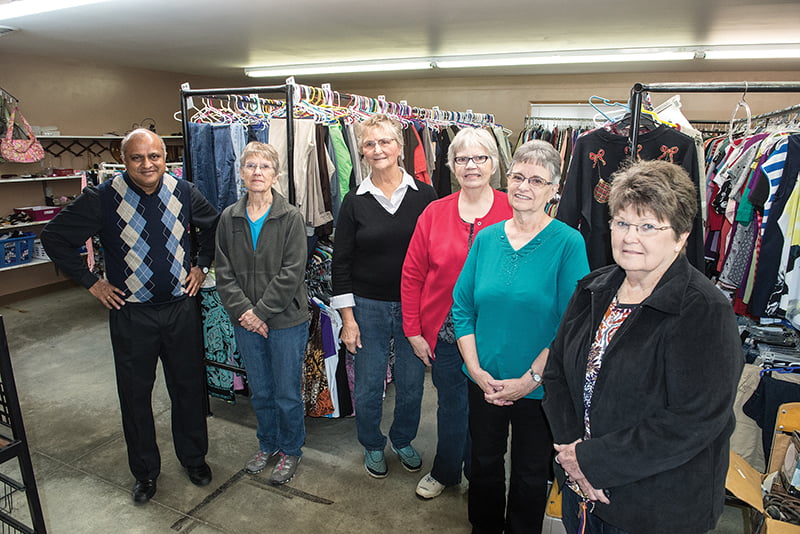
With Father Arul Carasala in the clothing section of the Seneca Mission Center are (from left) advisory committee members Rita Robke, Cleta Renyer, Laura Schmelzle, Mary Ann Augsness and Gladys Koch. They, and 60 volunteers, make the ministry a force for good in Seneca and beyond. PHOTO BY JOE BOLLIG
by Joe Bollig
joe.bollig@theleaven.org
SENECA — For many people, making it or breaking it is a matter of the margin.
For one woman suffering from cancer, the margin was crossed by one more medical bill. This time, it was almost $1,000, and she couldn’t pay it.
Fortunately, Father Arul Carasala found out.
“There was a lady going through chemo treatment,” said Father Carasala, pastor of Sts. Peter and Paul Parish in Seneca. “Her sister told me she had a bill that was not covered by insurance: $980. She was really worried how she would pay it.”
Neither the lady nor her sister asked for help, but Father Carasala wrote a check for $1,000 and sent it to the sick woman so she could pay the bill.
Later, the woman sent back the extra $20. After all, it was “extra.”
This is something that happens all the time in Seneca, thanks to Father Carasala’s extraordinary listening skills — and a humble money-generating miracle called the Mission Center.
Just recently, Father Carasala handed parish secretary Marian Rottinghaus four checks and told her to find the addresses of the recipients. None of them asked for the money or knew it was on the way, but they needed it — and Father Carasala knew it.
“Father Arul has ears bigger than his body,” said Rottinghaus. “He listens to everyone’s ills and problems. And before I know it, I’m mailing out checks to people who didn’t come in for anything.”
A few times, the money has been refused. Other persons need it more, they have told Father Carasala.
And the money doesn’t just stay in Seneca. Checks have gone out to people in the surrounding areas and religious communities in Nebraska, Kansas, Missouri, and — get this — Brazil.
The Mission Center is one of those quirky little phenomena that you occasionally discover in small towns like Seneca. It is part hangout, bargain barn, social service agency and church ministry.
Since 1990, the Mission Center has been housed in a nondescript brick ranch house on Amador Street across from the church. In the beginning, it was much smaller — a two-room, one-woman charity founded by the late Theresa Rilinger in 1954.
“She had one room in her house where she had clothing and things like that, and one little garage,” said Mary Ann Haugsness, a volunteer. “If they couldn’t afford them, she’d give it to them. It was a charity project; she helped the needy.”
Over the years, the Mission Center changed leadership and locations, growing in size and scope. It is now a parish ministry with an advisory committee and president. They, too, serve as “ears” for the Mission Center, finding out those needing help in the community who haven’t necessarily asked for it.
Recently, long-serving president Alice Macke was succeeded by Rita Robke. She was appointed by Father Carasala.
The Mission Center functions like the typical charity rummage house. People donate gently used items, which are then cleaned and repaired, and then put on the shelves for sale.
If a family or individual is in need — of clothes, toys, household items, furniture — the Mission Center gives it to them for free.
The money generated by sales is used for various “do-good” purposes. On average, the Mission Center generates $3,000 to $4,000 a month. There is no paid staff. About 60 parish volunteers do everything — collecting, sorting, cleaning, fixing, stocking and so on.
The aid of the Mission Center can be divided into three categories: prayer, material goods and financial assistance. And the people who are helped can be grouped roughly into three classifications: the sick and suffering, the financially strapped, and distressed travelers.
“Just recently, we had a family move to town and the husband hadn’t started working yet,” said Haugsness. “They were in need of a bed, pots and pans, and things like that. We helped them get started, and they were very grateful for that. Now they’re coming in and shopping.”
“We’ve helped hundreds of families,” said Father Carasala.
Since the next closest rummage house/thrift store is 30 miles away, the Mission Center gets visitors from as far away as Nebraska and Topeka.
“We are a quality maintained store,” said Father Carasala.
Three or four times a month, items that aren’t needed in Seneca are donated to the Topeka Rescue Mission.
One thing the Mission Center doesn’t do is act as a food pantry. There’s already one in town, and the center supports it.
What’s the best thing about the Mission Center? That’s hard to say, according to Haugsness and Father Carasala.
Maybe it’s the way it pulls in support from the whole community. Maybe it’s the center’s nonjudgmental, generous approach. Maybe it’s the variety of needs it fills.
Or maybe it’s just the practical, concrete way it dispenses mercy — even now that the Year of Mercy is over.
“We are carrying out the mission of Sts. Peter and Paul Church,” said Father Carasala. “We are a faithful community, and we try to implement the acts of mercy.”
“We’re doing what God wants us to do,” said Haugsness.
The needs of people are still great, and Father Carasala would like to expand, if that is possible.
“At this point, we are exploring options for what is best for the Mission Center,” he said. “We are still in the planning process.”






